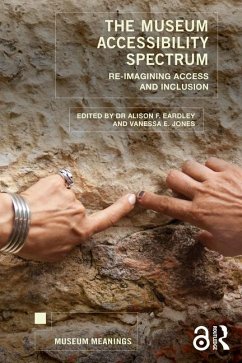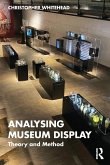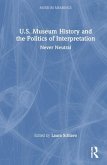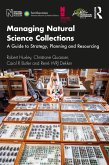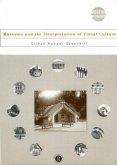The Museum Accessibility Spectrum
Re-Imagining Access and Inclusion
Herausgeber: Eardley, Alison F; Jones, Vanessa E
The Museum Accessibility Spectrum
Re-Imagining Access and Inclusion
Herausgeber: Eardley, Alison F; Jones, Vanessa E
- Broschiertes Buch
- Merkliste
- Auf die Merkliste
- Bewerten Bewerten
- Teilen
- Produkt teilen
- Produkterinnerung
- Produkterinnerung
The Museum Accessibility Spectrum volume engages with discussions around access to museums and argues that what is impairing the progress of museums towards inclusion is the current ableist model of access.
Andere Kunden interessierten sich auch für
![Analysing Museum Display Analysing Museum Display]() Christopher Whitehead (UK Newcastle University)Analysing Museum Display58,99 €
Christopher Whitehead (UK Newcastle University)Analysing Museum Display58,99 €![U.S. Museum Histories and the Politics of Interpretation U.S. Museum Histories and the Politics of Interpretation]() U.S. Museum Histories and the Politics of Interpretation195,99 €
U.S. Museum Histories and the Politics of Interpretation195,99 €![Managing Natural Science Collections Managing Natural Science Collections]() Robert Huxley (Natural History Museum, London, UK)Managing Natural Science Collections50,99 €
Robert Huxley (Natural History Museum, London, UK)Managing Natural Science Collections50,99 €![U.S. Museum Histories and the Politics of Interpretation U.S. Museum Histories and the Politics of Interpretation]() U.S. Museum Histories and the Politics of Interpretation51,99 €
U.S. Museum Histories and the Politics of Interpretation51,99 €![The Museums and Collections of Higher Education The Museums and Collections of Higher Education]() Andrew SimpsonThe Museums and Collections of Higher Education40,99 €
Andrew SimpsonThe Museums and Collections of Higher Education40,99 €![Leadership of Inclusive and Sustainable Cultural Organisations Leadership of Inclusive and Sustainable Cultural Organisations]() Piotr BienkowskiLeadership of Inclusive and Sustainable Cultural Organisations49,99 €
Piotr BienkowskiLeadership of Inclusive and Sustainable Cultural Organisations49,99 €![Museums and the Interpretation of Visual Culture Museums and the Interpretation of Visual Culture]() Eilean Hooper-GreenhillMuseums and the Interpretation of Visual Culture57,99 €
Eilean Hooper-GreenhillMuseums and the Interpretation of Visual Culture57,99 €-
-
-
The Museum Accessibility Spectrum volume engages with discussions around access to museums and argues that what is impairing the progress of museums towards inclusion is the current ableist model of access.
Hinweis: Dieser Artikel kann nur an eine deutsche Lieferadresse ausgeliefert werden.
Hinweis: Dieser Artikel kann nur an eine deutsche Lieferadresse ausgeliefert werden.
Produktdetails
- Produktdetails
- Museum Meanings
- Verlag: Taylor & Francis Ltd
- Seitenzahl: 296
- Erscheinungstermin: 16. Januar 2025
- Englisch
- Abmessung: 234mm x 156mm x 17mm
- Gewicht: 484g
- ISBN-13: 9781032466613
- ISBN-10: 1032466618
- Artikelnr.: 71746016
- Herstellerkennzeichnung
- Libri GmbH
- Europaallee 1
- 36244 Bad Hersfeld
- gpsr@libri.de
- Museum Meanings
- Verlag: Taylor & Francis Ltd
- Seitenzahl: 296
- Erscheinungstermin: 16. Januar 2025
- Englisch
- Abmessung: 234mm x 156mm x 17mm
- Gewicht: 484g
- ISBN-13: 9781032466613
- ISBN-10: 1032466618
- Artikelnr.: 71746016
- Herstellerkennzeichnung
- Libri GmbH
- Europaallee 1
- 36244 Bad Hersfeld
- gpsr@libri.de
Alison F. Eardley is an interdisciplinary researcher, trained in cognitive psychology (and employed in the School of Social Sciences at the University of Westminster, London, UK). Building on her previous work on imagery, imagination, and spatial processing in congenitally totally blind people and the sighted, her work is now focused on access, inclusion, interpretation, and evaluation within the museum sector. Vanessa E. Jones is the Access Programs Manager at the Smithsonian National Portrait Gallery, where she has championed accessibility initiatives since 2015. With degrees in art history and museum education, she develops and implements programs that enhance the museum experience for all visitors, particularly those with disabilities. Her expertise in access and inclusion has shaped institutional practices across the museum.
List of figures; List of contributors; Section 1 - Introduction: Chapter 1:
The Museum Accessibility Spectrum: recognising the multidimensional access
needs of all museum audiences; Chapter 2: Unpicking ableism and disablism
in museums: Why access should be for all; Section 2 - Disability Gain:
Chapter 3: Feeling Our Way: Anti-Ableist Provocations for the Future of
Inclusive Design in Museums; Chapter 4: Developing the Calm Room: A Journey
of Creating an Accessible Space for Inclusion and Well-being; Chapter 5:
French Nineteenth-Century Art Writing as Audio Description: the case of
Edouard Manet; Chapter 6: Seeing the Deaf Visitor: Improving Accessibility
Through a Critical Studies Lens; Chapter 7: Blundering into Sensorial
Conversation; Section 3: Social and Cultural Inclusion: Chapter 8: Social
and cultural barriers to inclusion: class and race at the Bethnal Green
Museum of Childhood; Chapter 9: Going Through the Portal: Permeable Walls
and Immersive Community Engagements rooted in Disability Justice; Chapter
10: What is a museum? Reframing the power dynamic between museums and
audiences ; Chapter 11: Stepping Aside: A reflection on how Museums can
transfer power to communities, open up collections, and increase access
through the creation of memory boxes; Chapter 12: The Sacred Cave of
Kamukuwaká: Enabling Digital Futures for Indigenous Cultural Heritage in
the Amazonian Xingu; Section 4: Agents of Social Change: Chapter 13: No
laughing matter? Reimagining the statuette of a 'comic' actor with dwarfism
at the British Museum; Chapter 14: Curating for Change: How can D/deaf,
disabled and neurodivergent curators drive change in museums in terms of
cultural representation and inclusive interpretation?; Chapter 15:
Inclusive Design and Accessibility: A Methodology of Perpetual Evolution
and Innovation; Chapter 16: Cultural Inclusion in Times of Crisis: Old and
New Traumas; Chapter 17: Museums for Equality: Combating Prejudice,
Promoting Human Rights and Practices of Social Inclusion in Egypt's
Museums; Section 5: Museum Futures: Instigators of change: Museums as
inclusive, accessible, equitable, participatory hubs; Acknowledgements;
Index.
The Museum Accessibility Spectrum: recognising the multidimensional access
needs of all museum audiences; Chapter 2: Unpicking ableism and disablism
in museums: Why access should be for all; Section 2 - Disability Gain:
Chapter 3: Feeling Our Way: Anti-Ableist Provocations for the Future of
Inclusive Design in Museums; Chapter 4: Developing the Calm Room: A Journey
of Creating an Accessible Space for Inclusion and Well-being; Chapter 5:
French Nineteenth-Century Art Writing as Audio Description: the case of
Edouard Manet; Chapter 6: Seeing the Deaf Visitor: Improving Accessibility
Through a Critical Studies Lens; Chapter 7: Blundering into Sensorial
Conversation; Section 3: Social and Cultural Inclusion: Chapter 8: Social
and cultural barriers to inclusion: class and race at the Bethnal Green
Museum of Childhood; Chapter 9: Going Through the Portal: Permeable Walls
and Immersive Community Engagements rooted in Disability Justice; Chapter
10: What is a museum? Reframing the power dynamic between museums and
audiences ; Chapter 11: Stepping Aside: A reflection on how Museums can
transfer power to communities, open up collections, and increase access
through the creation of memory boxes; Chapter 12: The Sacred Cave of
Kamukuwaká: Enabling Digital Futures for Indigenous Cultural Heritage in
the Amazonian Xingu; Section 4: Agents of Social Change: Chapter 13: No
laughing matter? Reimagining the statuette of a 'comic' actor with dwarfism
at the British Museum; Chapter 14: Curating for Change: How can D/deaf,
disabled and neurodivergent curators drive change in museums in terms of
cultural representation and inclusive interpretation?; Chapter 15:
Inclusive Design and Accessibility: A Methodology of Perpetual Evolution
and Innovation; Chapter 16: Cultural Inclusion in Times of Crisis: Old and
New Traumas; Chapter 17: Museums for Equality: Combating Prejudice,
Promoting Human Rights and Practices of Social Inclusion in Egypt's
Museums; Section 5: Museum Futures: Instigators of change: Museums as
inclusive, accessible, equitable, participatory hubs; Acknowledgements;
Index.
List of figures; List of contributors; Section 1 - Introduction: Chapter 1:
The Museum Accessibility Spectrum: recognising the multidimensional access
needs of all museum audiences; Chapter 2: Unpicking ableism and disablism
in museums: Why access should be for all; Section 2 - Disability Gain:
Chapter 3: Feeling Our Way: Anti-Ableist Provocations for the Future of
Inclusive Design in Museums; Chapter 4: Developing the Calm Room: A Journey
of Creating an Accessible Space for Inclusion and Well-being; Chapter 5:
French Nineteenth-Century Art Writing as Audio Description: the case of
Edouard Manet; Chapter 6: Seeing the Deaf Visitor: Improving Accessibility
Through a Critical Studies Lens; Chapter 7: Blundering into Sensorial
Conversation; Section 3: Social and Cultural Inclusion: Chapter 8: Social
and cultural barriers to inclusion: class and race at the Bethnal Green
Museum of Childhood; Chapter 9: Going Through the Portal: Permeable Walls
and Immersive Community Engagements rooted in Disability Justice; Chapter
10: What is a museum? Reframing the power dynamic between museums and
audiences ; Chapter 11: Stepping Aside: A reflection on how Museums can
transfer power to communities, open up collections, and increase access
through the creation of memory boxes; Chapter 12: The Sacred Cave of
Kamukuwaká: Enabling Digital Futures for Indigenous Cultural Heritage in
the Amazonian Xingu; Section 4: Agents of Social Change: Chapter 13: No
laughing matter? Reimagining the statuette of a 'comic' actor with dwarfism
at the British Museum; Chapter 14: Curating for Change: How can D/deaf,
disabled and neurodivergent curators drive change in museums in terms of
cultural representation and inclusive interpretation?; Chapter 15:
Inclusive Design and Accessibility: A Methodology of Perpetual Evolution
and Innovation; Chapter 16: Cultural Inclusion in Times of Crisis: Old and
New Traumas; Chapter 17: Museums for Equality: Combating Prejudice,
Promoting Human Rights and Practices of Social Inclusion in Egypt's
Museums; Section 5: Museum Futures: Instigators of change: Museums as
inclusive, accessible, equitable, participatory hubs; Acknowledgements;
Index.
The Museum Accessibility Spectrum: recognising the multidimensional access
needs of all museum audiences; Chapter 2: Unpicking ableism and disablism
in museums: Why access should be for all; Section 2 - Disability Gain:
Chapter 3: Feeling Our Way: Anti-Ableist Provocations for the Future of
Inclusive Design in Museums; Chapter 4: Developing the Calm Room: A Journey
of Creating an Accessible Space for Inclusion and Well-being; Chapter 5:
French Nineteenth-Century Art Writing as Audio Description: the case of
Edouard Manet; Chapter 6: Seeing the Deaf Visitor: Improving Accessibility
Through a Critical Studies Lens; Chapter 7: Blundering into Sensorial
Conversation; Section 3: Social and Cultural Inclusion: Chapter 8: Social
and cultural barriers to inclusion: class and race at the Bethnal Green
Museum of Childhood; Chapter 9: Going Through the Portal: Permeable Walls
and Immersive Community Engagements rooted in Disability Justice; Chapter
10: What is a museum? Reframing the power dynamic between museums and
audiences ; Chapter 11: Stepping Aside: A reflection on how Museums can
transfer power to communities, open up collections, and increase access
through the creation of memory boxes; Chapter 12: The Sacred Cave of
Kamukuwaká: Enabling Digital Futures for Indigenous Cultural Heritage in
the Amazonian Xingu; Section 4: Agents of Social Change: Chapter 13: No
laughing matter? Reimagining the statuette of a 'comic' actor with dwarfism
at the British Museum; Chapter 14: Curating for Change: How can D/deaf,
disabled and neurodivergent curators drive change in museums in terms of
cultural representation and inclusive interpretation?; Chapter 15:
Inclusive Design and Accessibility: A Methodology of Perpetual Evolution
and Innovation; Chapter 16: Cultural Inclusion in Times of Crisis: Old and
New Traumas; Chapter 17: Museums for Equality: Combating Prejudice,
Promoting Human Rights and Practices of Social Inclusion in Egypt's
Museums; Section 5: Museum Futures: Instigators of change: Museums as
inclusive, accessible, equitable, participatory hubs; Acknowledgements;
Index.

